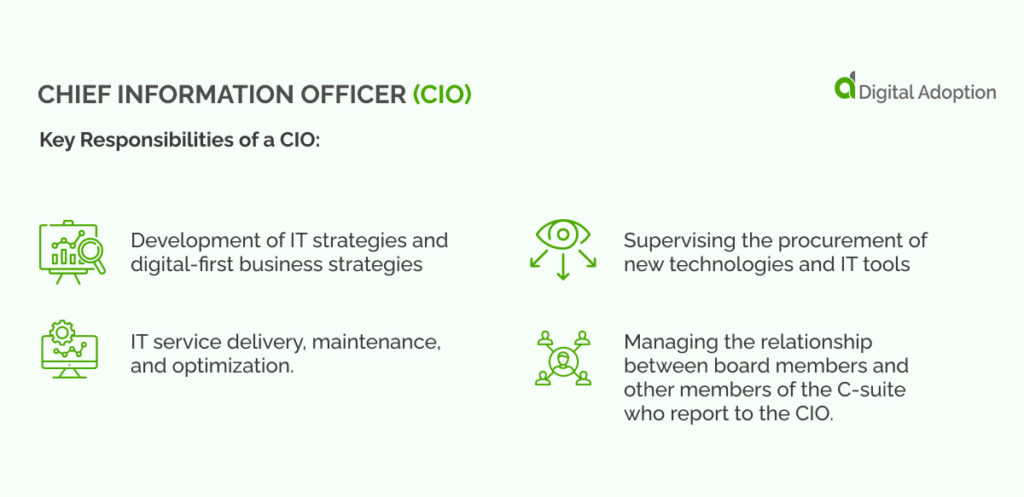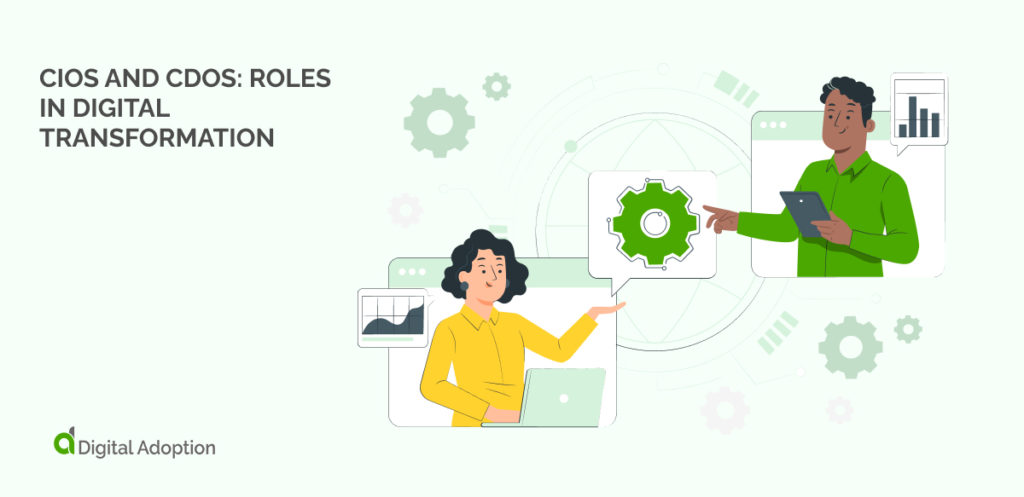CIO, CDO, CTO.
What’s the difference, and who takes the reigns in a digital transformation effort?
Most companies have a business or IT leader at the executive level in one or more of these roles. They work closely with one another, but each role has distinctly different jobs.
The problem is that the titles do little to illustrate the critical differences between CIOs, CDOs, and CTOs.
To complicate matters further, CDO is used interchangeably to refer to both Chief Digital Officer and Chief Data Officer— two positions with the same abbreviation but very different roles.
It’s safe to say that not all companies opt to fill all these roles, but for those that do, all employees must understand the distinctions between them. Digital adoption largely depends on the roles and responsibilities of those tasked with driving it.
This article will look at all these roles in more detail. We’re going to focus on each role’s responsibility within traditional businesses.
Chief Information Officer (CIO)

A Chief Information Officer (CIO) is typically responsible for the overall IT strategy and implementation of a company’s technology infrastructure. They need to align IT strategy with business priorities.
Key Responsibilities of a CIO:
- Development of IT strategies and digital-first business strategies
- Supervising the procurement of new technologies and IT tools
- IT service delivery, maintenance, and optimization.
- Managing the relationship between board members and other members of the C-suite who report to the CIO.
In short, Chief Information Officers are often the highest-level IT leaders in an organization. Many other IT leaders, including CDOs, report directly to the CIO, who, in turn, reports to the CEO and the board.
Chief Data Officer (CDO)

A Chief Data Officer (CDO) is a senior executive with expertise in data. They focus on how data can drive innovation and improve company operations.
The CDO role produces data-driven insights- a relatively new concept— but highly sought after by modern companies.
With the rise of Big Data, CDOs can help make the most of enterprise data, analytics, AI, and related technologies to predict and respond to risks and opportunities.
Key Responsibilities of a CDO:
- Development of a company’s data strategy and aligning that strategy with business objectives
- Overseeing data lifecycle management and keeping data quality high.
- Optimizing the company’s use of data
- Leading initiatives related to data
Companies must understand that the CDO role is still relatively new and evolving. Only some companies will need a CDO, and other departments might still be responsible for specific data types.
Chief Digital Officer (CDO)

The CDO is another IT leadership role focusing on digitally transforming traditional businesses– translating analog business processes into digital ones.
Examples of digitization include using digital records instead of physical ones or online conferencing instead of conferencing on the telephone.
This role became quite popular, with nearly one in five large companies employing a CDO, according to PwC. However, other research suggests that this role may decline and that many CDOs had difficulty accomplishing their main objective: digital transformation.
A fundamental problem, according to one officer quoted by the World Economic Forum, had to do with the attitudes of the hiring company:
“It’s less about digital than transformation. And transformation is not welcome anywhere because it’s a big change. Nobody wants to change because you are changing ways of working, behaviors, and sometimes territories. Fear is a very important component of our role. People fear change.”
This last point, the fear of change, highlights the disconnect between the “dream” of digital transformation and the realities that come with organizational change. Namely, change does deliver benefits, but the road to transformation takes work and can be frightening.
In short, as the author of the article above put it:
“CDOs do not fail because they are unqualified, unmotivated, or incompetent. They fail because they are set up to fail.”

Despite the lackluster performance of this position, digital transformation is here to stay – under the leadership of other executives, such as the CIO.
Key Responsibilities of a CDO:
- Managing digital transformation efforts within an organization.
- Take responsibility for the risks associated with organizational change.
- Promote a culture of agility and open communication.
- Constantly challenge the status quo within the industry.
Chief Technology Officer (CTO)

Like the CDO, the Chief Technology Officer (CTO) is a role that sits under and reports to the CIO in a typical company. CIOs and CTOs are commonly conflated.
In the way of similarities, both CIOs and CTOs need strong business understanding and excellent technical knowledge.
However, the difference between a CTO and CIO is that the CTO position is a more customer-facing role. The goal of a CTO is to use technology to enhance the company’s offerings and external products. They must inhabit a customer’s mindset and know how to leverage technology to provide a better experience to external customers.
Key responsibilities of a CTO:
- Experimenting with new tech stacks to generate business value.
- Managing client relations and ensuring that service objective expectations are met.
- Lead in developing new technologies and new e-commerce offerings.
- Manage the physical and personnel technology infrastructure.
Chief Technology Officers usually have the straightforward task of generating more revenue as one of their metrics for success. While that goal is straightforward, one of the many skills needed for a successful CTO is the ability to measure value at every stage.
CIOs and CDOs: Roles in Digital Transformation

Many companies, as mentioned, have hired CDOs to help their business to focus on new digital-first operating models.
Yet rather than hiring a new position to lead digital transformation efforts, many are turning to their own CIOs for help.
For instance, according to research firms such as Gartner, among others, Chief Information Security Officers are responsible for the following:
- Designing and leading digital transformation initiatives
- Investing in emerging technology
- Creating digital innovation hubs in the company
- Educating other executives on the value of digital technology
- Cultivating a digital-first culture within the company
In short, CIOs are extending their responsibilities beyond IT service management (ITSM) to include business strategy and the six sigma process of business transformation.
Since they are already part of the business hierarchy, they are often better positioned to lead digital transformation efforts.
Also, as the de facto IT leaders within the company, the Chief Data Officers will usually report to them. While CDOs may not be directing digital transformation efforts, they are still crucial – and as big data, AI, and analytics become more prevalent, the CDO’s role will become even more important.
This means that understanding the chief data and analytics officer roles in business is crucial for future success.
How Can CIOs Support CDOs and CTOs?

A rising tide raises all ships, so what can CIOs do to get the most out of the executives that report to them?
- Encourage CDOs and CTOs to Collaborate
Chief Digital and Chief Technology Officers share similar roles. Both explore strategies for emerging technologies. The difference is that CDOs are internal-facing, and CTOs are external-facing.
That difference isn’t as big as it sounds. Many emerging technologies can be beneficial for not only internal business services but also customers.
It can be an effective strategy to adopt a tool internally, train employees on it, use it, and then offer it to customers. You then have the added advantage of your workforce knowing the tool well and being able to support the customer journey better as a result.
- Take an Agile Approach
The key lesson from Agile that applies here is to ensure your CDOs and CTOs have everything they need— then get out of their way.
Both roles are leadership positions. It’s important to give them the flexibility to lead as they see fit.
- Link Operations and Strategy for Stakeholders’ Sake
CDOs work primarily on back-office projects in which stakeholders aren’t as interested— usually because they don’t directly generate more revenue.
A great CIO links internal business operations to the wider business strategy and recognizes the achievements of internal business services.
This is an important piece of the puzzle for generating morale and motivation.
- Keep Communication Open
This is another Agile principle, but it deserves its own mention.
Keeping communication channels open flattens the hierarchy— and that’s not something to be afraid of.
A flat hierarchy is not a threat to a CIO or a sign of a bad CIO.
Flat hierarchies where communication is open and fast lead to faster decisions. This lets businesses react to issues more quickly and adapt to rapidly changing markets.
Key Takeaways

In the past, the sole focus of the CIO role was IT service management, but that is changing as modern companies evolve. The modern CIO focuses on strategy and vision and delegates daily operations.
That said, while the CDO has led digitization in many organizations, there are signs that the CIO is taking the helm and that the CDO role might fade out.
CIOs, as a result, are often responsible for designing and leading digital transformation efforts, with support from other IT leaders.
Chief Data Officers, for instance, have become more necessary as data-driven technology becomes more and more common. In the years ahead, we can expect CIOs and CDOs to be more prominent in digital transformation leadership.
These roles are distinctly specialized, and while you don’t need to fill them, it’s worth considering who in your business wears each hat. That way, you can ensure your bases are covered when trying to get the most out of information technology.













